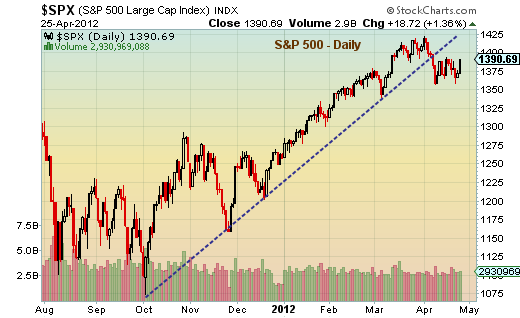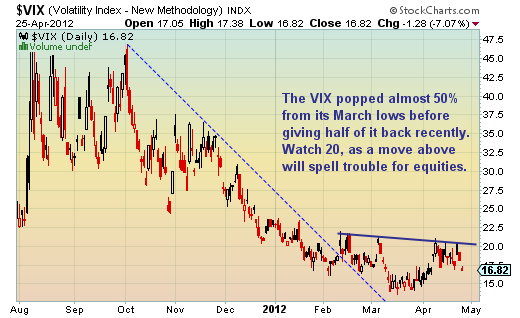 By Joshua Schroeder
By Joshua Schroeder
Volatility comes from out of nowhere and tends to take people by surprise. A bit of a rounding top and some indecision, and suddenly it appeared, ready to do battle with the multi-month build up of complacency.
This volatility was largely absent during the earlier part of the year when the market realized most of its gains. And it is for this reason that I am questioning and wondering about this change in character and what it might mean for the rest of 2012.

 Are the infusions of liquidity, encouraging economic news and recent bank stress tests that have pushed this bull market to nearly a 12% gain with only three months on the books enough to support the market going forward? In short, I do not believe they are and I think the return of volatility is telling us that 1400-1450 may as high as we get in 2012.
Are the infusions of liquidity, encouraging economic news and recent bank stress tests that have pushed this bull market to nearly a 12% gain with only three months on the books enough to support the market going forward? In short, I do not believe they are and I think the return of volatility is telling us that 1400-1450 may as high as we get in 2012.
With the slow summer months ahead (read: “Sell in May and Go Away”) and the US presidential election kicking into high gear I expect that even continued positive economic news will be overshadowed by unresolved policy issues both in the US and Europe. Later in May, Greek and French elections should bring uncertainty to the markets. And further, as we move into the summer months, rising gasoline prices should add pressure to an already slow economy.
Although I wouldn’t be surprised by a marginal new high in May, I am nonetheless leaning bearish intermediate term and expecting and waiting for an eventual pullback of close to 10% before putting funds back to work in beta assets. I will be investing in securities that “pay me to wait” and have strong cash flow fundamentals while leaving approximately 40% of my portfolio in cash. In other words, I believe the summer months will be more about risk management and capital preservation than capital appreciation.
In the medium to long term I am still bullish and will continue to look for investments that will benefit from the growth of the emerging market middle class and the rebalance of demand from the developed to the developing world.
—————————————————————-
Any opinions expressed herein are solely those of the author, and do not in any way represent the views or opinions of his employer or any other person or entity.
No positions in any of the securities mentioned at the time of publication.
Twitter: @JoshuaSchroede2 and @seeitmarket Facebook: See It Market








